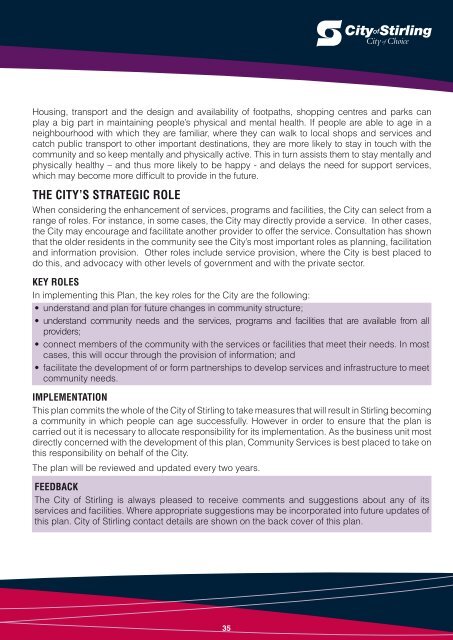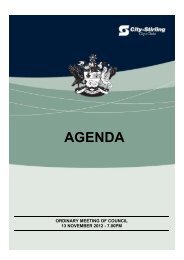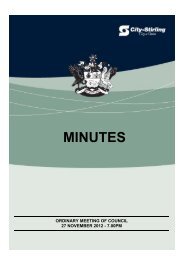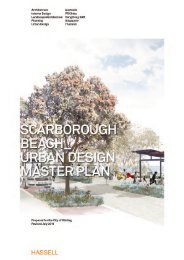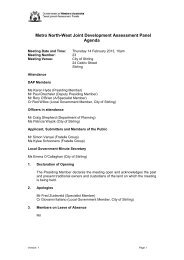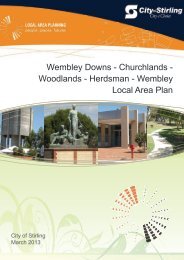Seniors Plan 2007 - City of Stirling - The Western Australian ...
Seniors Plan 2007 - City of Stirling - The Western Australian ...
Seniors Plan 2007 - City of Stirling - The Western Australian ...
Create successful ePaper yourself
Turn your PDF publications into a flip-book with our unique Google optimized e-Paper software.
Housing, transport and the design and availability <strong>of</strong> footpaths, shopping centres and parks can<br />
play a big part in maintaining people’s physical and mental health. If people are able to age in a<br />
neighbourhood with which they are familiar, where they can walk to local shops and services and<br />
catch public transport to other important destinations, they are more likely to stay in touch with the<br />
community and so keep mentally and physically active. This in turn assists them to stay mentally and<br />
physically healthy – and thus more likely to be happy - and delays the need for support services,<br />
which may become more difficult to provide in the future.<br />
THE CITY’S STRATEGIC ROLE<br />
When considering the enhancement <strong>of</strong> services, programs and facilities, the <strong>City</strong> can select from a<br />
range <strong>of</strong> roles. For instance, in some cases, the <strong>City</strong> may directly provide a service. In other cases,<br />
the <strong>City</strong> may encourage and facilitate another provider to <strong>of</strong>fer the service. Consultation has shown<br />
that the older residents in the community see the <strong>City</strong>’s most important roles as planning, facilitation<br />
and information provision. Other roles include service provision, where the <strong>City</strong> is best placed to<br />
do this, and advocacy with other levels <strong>of</strong> government and with the private sector.<br />
Key Roles<br />
In implementing this <strong>Plan</strong>, the key roles for the <strong>City</strong> are the following:<br />
• understand and plan for future changes in community structure;<br />
• understand community needs and the services, programs and facilities that are available from all<br />
providers;<br />
• connect members <strong>of</strong> the community with the services or facilities that meet their needs. In most<br />
cases, this will occur through the provision <strong>of</strong> information; and<br />
• facilitate the development <strong>of</strong> or form partnerships to develop services and infrastructure to meet<br />
community needs.<br />
Implementation<br />
This plan commits the whole <strong>of</strong> the <strong>City</strong> <strong>of</strong> <strong>Stirling</strong> to take measures that will result in <strong>Stirling</strong> becoming<br />
a community in which people can age successfully. However in order to ensure that the plan is<br />
carried out it is necessary to allocate responsibility for its implementation. As the business unit most<br />
directly concerned with the development <strong>of</strong> this plan, Community Services is best placed to take on<br />
this responsibility on behalf <strong>of</strong> the <strong>City</strong>.<br />
<strong>The</strong> plan will be reviewed and updated every two years.<br />
Feedback<br />
<strong>The</strong> <strong>City</strong> <strong>of</strong> <strong>Stirling</strong> is always pleased to receive comments and suggestions about any <strong>of</strong> its<br />
services and facilities. Where appropriate suggestions may be incorporated into future updates <strong>of</strong><br />
this plan. <strong>City</strong> <strong>of</strong> <strong>Stirling</strong> contact details are shown on the back cover <strong>of</strong> this plan.<br />
35


